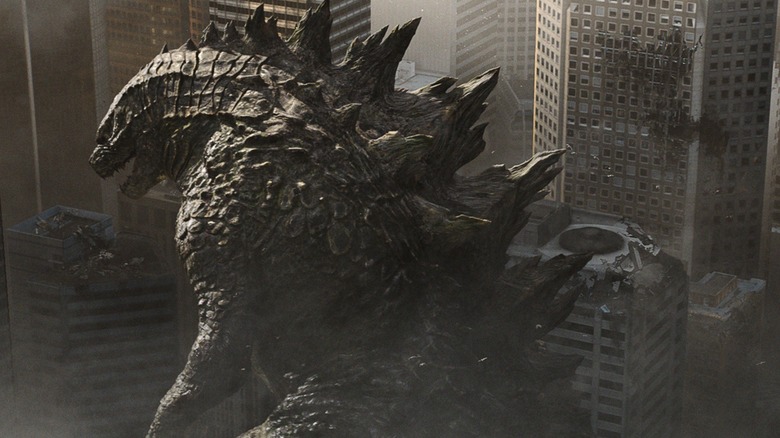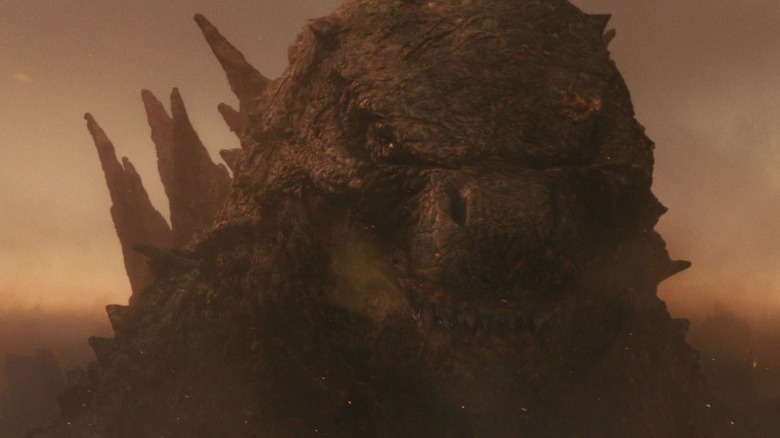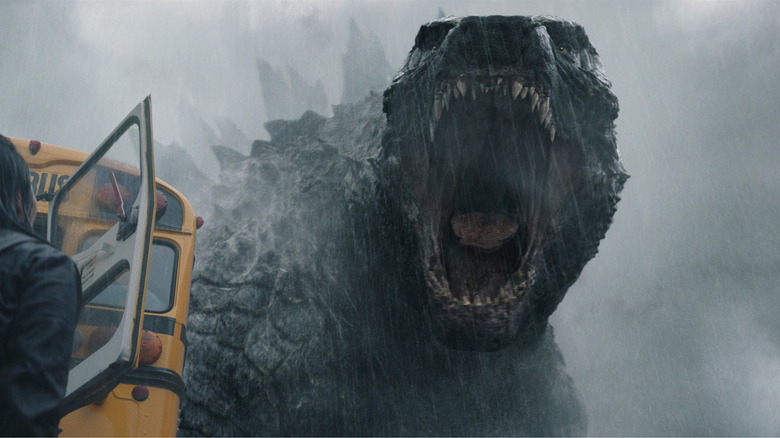Godzilla's Iconic Roar Consists Of More Random Sounds Than You May Have Realized
When Godzilla gets mad, he yells at stuff. Dude loves to roar. When he's not stomping on cities, smashing King Ghidorah in the face(s), or hibernating in the Pacific, everyone's favorite nuclear gorilla-whale is sounding his barbaric yawp over the roofs of the world. The accepted spelling of Godzilla's roar is "SKREEONK," a word often seen in Godzilla comics. Since the monster's inception in 1954, Godzilla has more or less retained the same roar, with the sound only undergoing remixes and aural sweetening as sound technology evolved. The Godzilla roar from 2023's "Godzilla Minus One" is not terribly far afield from the Godzilla roar heard in Ishiro Honda's "Gojira." Enterprising Godzilla fans have compiled the various Godzilla roars into tidy video montages. It's a high-pitched wail undergirded by an animalistic growl. It is distinctly Godzilla.
In 2014, for the franchise's 60th anniversary, the Godzilla series was rebooted in America by American filmmakers. Called just "Godzilla," the new film was directed by Gareth Edwards and featured a new design and a new mythology for the famous monster. In the film, Godzilla did battle with creatures called MUTOs, which he handily dispatched with his nuclear breath. Naturally, the makers of this new Godzilla had to come up with a newly recorded, remixed version of the famed "Skreeonk" that Godzilla fans expected. It was no easy feat.
Back in 2014, "Godzilla" sound designers Ethan Van der Ryn and Erik Aadahl talked to NPR's "All Things Considered" to talk about the tricky balance of making a new Godzilla roar and the vast mixture of animal and non-animal sounds they mixed together.
Don't tell Gareth
Van der Ryn and Aadahl revealed that had a mandate for themselves: they wouldn't let director Gareth Edwards hear their Godzilla roar until it was on its "final draft," so to speak. Edwards, they felt, had to be able to recognize their noise as Godzilla's roar right away. Aadahl said:
"We actually decided not to tell him until a little more than a month ago, when we had finished the film. Because it's kind of like a magic trick. If you show, OK, the card is right here in the sleeve and I'm going to pull it out, and that's the trick, it kind of diffuses it. It ruins it."
According to the NPR article, Van der Ryn and Aadahl experimented with many different sounds while recreating the Godzilla roar. They scraped drumheads, opened creaky doors (which seems logical), and, perhaps strangest of all, used specialized scientific microphones that could capture noises beyond what the human ear could detect. They then remixed those sounds into audible frequencies and blended them with the sounds they already had. "That allowed us to [...] exploit this vast universe of sounds that really people have never heard before," Van der Ryn said. Edwards wasn't allowed to hear what they were doing, but Thomas Tull, the head of Legendary Entertainment, was able to give a thumbs-up or thumbs-down to their work as it progressed.
Naturally, they wanted their sounds to be as loud as possible. This was a Godzilla roar, after all, and should sound like it came from the largest land animal the world had ever seen. Luckily, Van der Ryn and Aadahl, at the time, were granted temporary access to some of the biggest, loudest speakers available: the same speakers used for Rolling Stones concerts.
Gimme, Gimme, Gimme the Honk-Skreeonk Blues
How, after all, does one hear what a Godzilla roar sounds like when it is echoing across a cityscape other than actually blasting it across a real city? Much of the monster mayhem in Edwards' "Godzilla" takes place in San Francisco, so Van der Ryn and Aadahl had to settle for the wilds of Burbank. It seems that their little sound experiment was so loud, it could be heard three miles away. Aadahl said:
"The neighbors started tweeting, like, 'Godzilla's at my apartment door!' [...] And we were getting phone calls from Universal Studios across town, because tour groups were asking, 'What's all that commotion going on down in the valley?' "
The two sound designers were also interviewed in a special documentary filmed for Rotten Tomatoes, and they talked a little bit more about how they started with the 1954 roar as a template, and what they added to it to make the new Godzilla stand out. The original Godzilla sound, they noted, was achieved by coating a leather glove in resin and stroking it across the strings of an upright bass. They did the same with the aforementioned tom drums. Like many monster roars of the modern age, it seemed important to have a "gug-gug-gug-gug-gug" effect, as if the noise was coming from a real animal throat.
Edwards noted that when he first heard the roar in Dolby Atmos, it was perfect.


